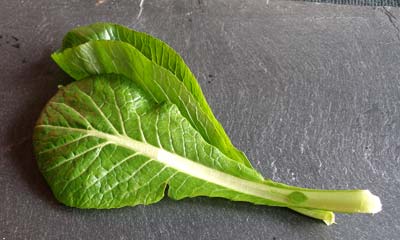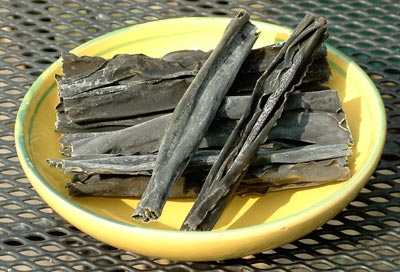
Chinese spinach mustard, with a flavour somewhere between spinach and cabbage. These greens may be cooked or eaten raw in salads.

Kelp seaweed, usually sold in dried strips. Kelp has the delicious taste characteristic of glutamic acid. The white powder on the surface of kelp contains a flavour component, so it shouldn't be wiped off. Kelp is rich in potassium, calcium, iodine and carotene. It also contains amino acids that help lower blood pressure. Choose blackish kelp that is lustrous and well-dried. This seaweed is used to make dashi and also appears in nabe dishes and wrapped around fish, which are then simmered. Kelp seaweed is used to season stocks, rice and vegetables. It is also cut into strips and made into little baskets which are fried and served with vegetables. To cook it, simply wipe a piece with a cloth and put it into 1 litre (2 pints) of water; bring it slowly to the boil and then simmer for about 5 minutes. Remove the kombu and keep for cooking with other ingredients. The stock may be used to add to soups, broths or stews. The konbu may be cut up and cooked with root vegetables seasoned with soy sauce or cooked with beans.
This vinegar is milder and has a gentler flavour than fruit and wine vinegars. Traditionally-brewed rice vinegars, which are fermented for several months, are superior to those that are synthetically produced. Rice vinegar, like other vinegar, helps food keep longer, prevents vegetables from discolouring and removes bitterness. Rice vinegar is used in dressings, sushi rice and pickles.
A type of gelatinous black bean curd or yam cake. It is processed from the taro-like, glutinous root of konnyaku yams or 'devil's tongue' (snake palm) into either solid, gelatinous, brownish cakes or into ito-konnyaku, i.e. spaghetti-like threads. The tubers are peeled, pounded vigorously, boiled and the curd precipitated out. It is calorie-free, is 90% water and helps cleanse the digestive system. Konnyaku is valued more for its spongy texture than flavour and is cut into strips and added to vegetable soups, salads and simmered dishes. It can either be unrefined, in which case it is a dirty grey, or refined by bleaching and filtering, in which case it is pearly white and comes in several different shapes. It is also available in tins.